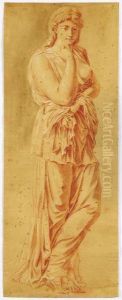Etienne Pierre Adrien Gois Paintings
Étienne Pierre Adrien Gois, born in 1731, was a French sculptor whose career spanned a significant period in European art history, marking the transition from the Rococo style of the early 18th century to the more sober, classical inclinations of Neoclassicism. His life and work offer a fascinating insight into the artistic movements and societal changes of his time. Born in Paris, Gois was deeply embedded in the rich cultural and artistic milieu of the French capital, which served as a fertile ground for his development as an artist.
Gois received his early training under the tutelage of his father, Pierre Gois, also a sculptor, which was common in the period for artistic skills to be passed down through generations. This initial training grounded him in the traditional techniques of sculpting, yet it was his admission to the prestigious Académie Royale de Peinture et de Sculpture that truly marked the beginning of his professional journey. The Académie was the heart of French artistic education and thought, and studying there allowed Gois to be exposed to the leading artists and ideas of his time.
Throughout his career, Gois became known for his skillful execution and ability to convey emotional depth and classical beauty in his works. His sculptures often reflected the ideals of Neoclassicism, emphasizing harmony, clarity, and the inspiration drawn from the ancient Greek and Roman art. This was in contrast to the ornate and decorative qualities of Rococo, signaling a shift in aesthetic preferences towards the end of the 18th century.
Despite the political turmoil and societal changes brought about by the French Revolution and the Napoleonic Wars, Gois managed to maintain a notable career. His ability to adapt to the changing tastes and political climates of his time may have contributed to his longevity in the highly competitive world of French art.
Étienne Pierre Adrien Gois passed away in 1823, leaving behind a legacy that encapsulated a pivotal moment in art history. His contributions to sculpture not only reflect the transition between major artistic movements but also serve as a testament to the enduring appeal of classical ideals in art. His works remain studied and admired for their technical mastery and emotional resonance, cementing his place in the annals of French sculpture.
